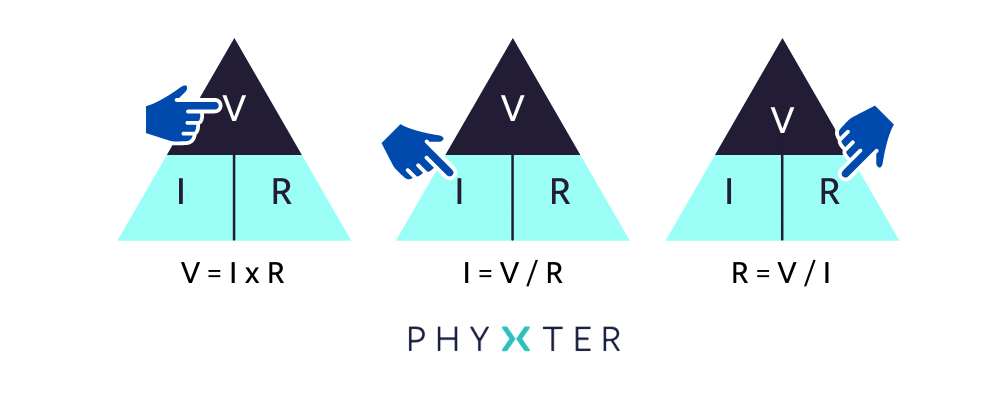Table of Contents
If you’re an electrician or HVAC technician, you need a firm grasp of Ohm’s law. It helps describe electrical circuits and the relationship between voltage and current. Understanding ohm’s law will allow you to control the current flow in a circuit and know when to add resistors.
Don’t Care? Just click here for our free Calculator for Ohms Law Wheel. It’s right here!
✅ How to Use Ohm’s Law
Ohm’s law says that the current between two points is directly proportional to the voltage across the two points in an electrical conductor. The best way to get to know this law is to use Ohms Law PIE chart.
It involves a simple formula with three electrical variables: voltage, current, and resistance.
- R is the resistance measured in ohms Ω
- I is current measured in amperes or amps
- V is measured in Volts = sometimes known as E (volts)
Imagine each letter (R, I, V) in the corner of a triangle, with V at the top. This visualization demonstrates the relationship between the variables. It can also help you determine how many amps a circuit will draw when you can’t utilize an ammeter.

Place your finger over the unit you want to calculate, whether that’s resistance, voltage, or current. Ohm’s law formula will take care of the rest. That’s because the current through the conductor’s two points is directly proportional to its voltage. Meanwhile, the electrical current is inversely proportional to resistance.
You can represent Ohm’s law wheel using the following mathematical equations:
- I (current) x R (resistance) = V (voltage)
- V (voltage) / I (current) = R (resistance)
- V (voltage) / R (resistance) = I (current)
If you have two known values, you can calculate the remaining unit using these formulas. First, plug the known values into the formula. Second, multiply or divide them (or use a calculator), depending on the other values. It’s that simple. 😉
✅ Examples of Ohm’s Law
We want to find the resistance measured in ohms of an electric circuit. We know the voltage is 24 volts, and the circuit has a resistance of six ohms.
How do we calculate the electric current? By putting the known values in the Ohm’s law formula wheel:
- 24 volts / 6 ohms = 4 amps
Now you know the missing variable’s value. You can use Ohm’s law whenever you know two unit variables in the formula.
Here’s another example in which you have 200 volts and 20 amps:
- 200 volts / 20 amps = 10 ohms
✅ Ohm’s Law Formula Wheel

Ohm’s law formula wheel adds one more variable: power (P) measured in Watts. In this case, power is defined as the rate energy is transferred by the circuit per unit time expressed in watts. The formula wheel combines the PIE chart with Ohm’s law. It contains four units. While the formula wheel may look complicated, it’s as easy to use as the PIE chart.
Each quadrant of the chart contains formulas that express the relationship between two variables, whether they’re directly proportional or not. You’ll find three formulas inside each quadrant.
📋 Here are four steps to follow when using Ohm’s law wheel.
- Determine what variable you need to solve for: power (P), resistance (R), amps (I), and volts (E or V).
- Determine what variables you already know: power (P), resistance (R), amps (I), and volts (E or V).
- Find the formula in which you can plug your two values.
- Solve the equation.
Make sure to use compatible units when solving the formula. If you’re using ohms and amperes, that’s okay because they work together.
However, if you have kilohms, you should convert the number to ohms before calculating the answer. Otherwise, you’ll get a much smaller result than expected. The same applies if you’re using kilowatts instead of watts or milliamperes instead of amperes.
✅ The Principles of Ohm’s Law
Ohm’s law offers a useful way to study the relationship between variables. All you have to do is change the value of one variable in the formula. As a result, you’ll see a proportional increase or decrease in the answer.
Let’s say you want to increase the resistance. That would impact the other components in the equations.
Here are three examples that depict this dynamic:
- 240 volts / 5 ohms = 48 amps
- 240 volts / 10 ohms = 24 amps
- 240 volts / 20 ohms = 12 amps
These formulas show the resistance increasing gradually. What happens as a result? The voltage rises, too, assuming that the resistance of the circuits doesn’t change.
Let’s try this example again while changing the voltage:
- 240 volts / 10 ohms = 24 amps
- 480 volts / 10 ohms = 48 amps
- 960 volts / 10 ohms = 96 amps
The voltage in these equations is steadily increasing. Meanwhile, the resistance remains the same. Therefore, the electrical energy in the current increases proportionally to the voltage.
✅ When to Use Ohm’s Law Wheel

Ohm’s law has no shortage of real-world applications. You can use the formulas for a wide range of problems in the HVAC world. For example, it’s a go-to option when dealing with an operating circuit.
Let’s say you cannot measure the resistance of an operating circuit. One option would be to turn off the circuit and measure the resistance that way. However, that option takes an unnecessary amount of time and effort. Ohm’s law wheel allows you to calculate the resistance value in seconds.
Ohm’s Law is also often combined with Joule’s Law (which uses the formula P (power) = IV to calculate power for resistive elements when a variable is unknown. For example, if you know the current (I) and resistance (R) but not the voltage, you can replace V in Joule’s Law with Ohm’s Law to find the power in watts. You would get P = I (IR).
As a rule of thumb, Ohm’s law works best with constant driving voltage or current.
Direct current (DC) circuits have a steady flow of electricity that’s straightforward to measure. Determining voltage and current becomes trickier if you don’t have this stability. For instance, you cannot apply the formulas when dealing with AC circuits, also known as time-varying circuits.
That’s because they don’t account for reactance, which you’d find in this type of circuit. Note that you can adjust the formulas to account for impedance (Z), but that’s a lesson for another article.
✅Ohm’s Law Calculator
Do you need to calculate an electrical current in a pinch? We have you covered with Ohm’s law calculator. The calculator can handle equations that utilize power, voltage, current, and resistance.
Enter two values and press “enter” to solve the formula.
While this calculator will make your job easier, Ohm’s law serves as the backbone for electrical work alongside other important formulas. Whether you’re an HVAC apprentice or a seasoned technician, you need a firm grasp of these concepts. You can use formulas to navigate various problems when dealing with electric power, resistive elements, voltage current, and more—and you may not always have access to a calculator!
Check out our blog for more tips, tricks, and insights.

